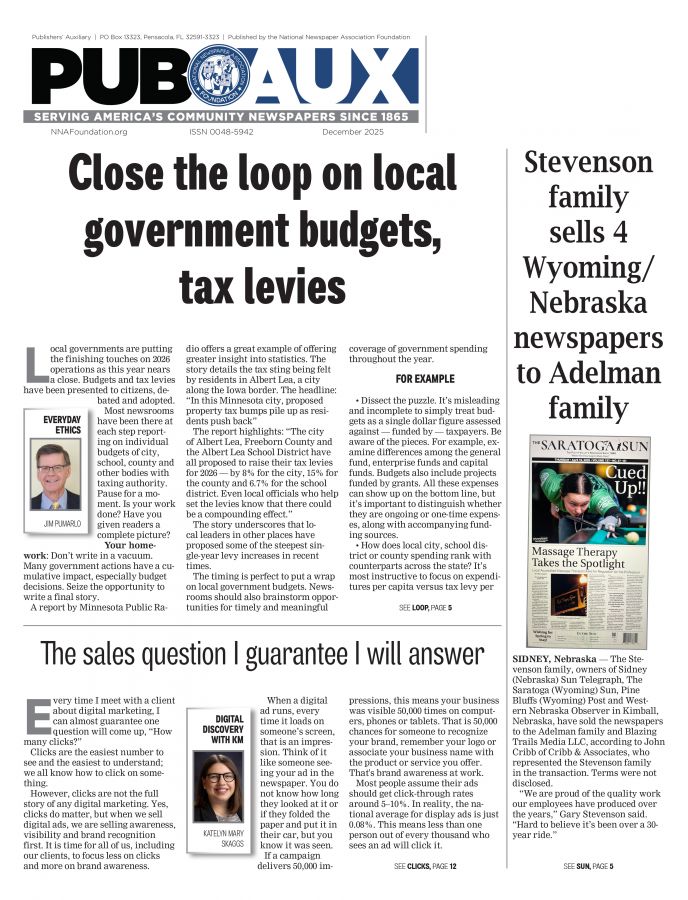Vibrant news product is key to generating revenue
Jim Pumarlo
May 1, 2025


Nothing’s worse than a reformed smoker, they say. Well, I might top that; nothing’s worse than a retired editor.
Editors and reporters must be well grounded in the basics of journalism if newspapers are to remain relevant and make their case to sell subscriptions and advertising. In other words, present the news in a manner that engages readers — especially in public affairs reporting.
Full disclosure: I offer news training. More important, I have a passion for community newspapers and believe they play a role in educating and engaging citizenry. I’ll never lose my newspaper blood after working nearly 30 years at community newspapers.
But it dismays me when I hear publishers jump at sending advertising and circulation staff to seminars on the premise of garnering ideas to generate revenue. Or sending reporters to sharpen skills? It’s unfortunately far down on many publishers’ priorities. The rationale? Reporters do little to boost the bottom line.
My apologies if I put on my editor’s hat for a moment, but isn’t the vitality of a newspaper’s content the prime selling point against other media for advertising and circulation departments?
It pains me to watch newspapers fall so woefully short in the basics of reporting news.
CONSIDER THESE EXAMPLES
- Be timely: A longstanding retail store changes ownership. The report appears seven months after the fact.
- Be relevant: A nonprofit housing agency proposes 26 residential plats on 4½ acres in the heart of an established neighborhood. The site has been vacant for years. The planning commission conducts the first public hearing; the newspaper does not attend and offers no report.
- Be clear: A newspaper reported on the bankruptcy proceedings of its parent company. The story read, in part, “ … the agreement is with the holders of more than 75% of its outstanding senior subordinated notes. If the restructuring is approved, the holders of the $278.5 million in outstanding notes would exchange their existing notes for $100 million of new second lien secured notes.” Can someone please decipher?
- Be inviting: The most compelling content will go unread if headlines are dull and lack distinction: “Downtown business owners and community members discuss plans for the future”
- Be engaging: Newspapers, as a clearinghouse of information “on” and “off” the record, are in excellent position to weigh in on issues vital to a community. Yet, fewer local editorials are being written, and too many are nondescript. Ditto for editorial pages, overall. The strongest commentaries advocate action in advance of a vote rather than weighing in after the fact.
- Be accessible: Publishing timely online updates is a must for visibility and survivability in the crowded social media landscape. Avoid web content that is simply a regurgitation of the print edition — a terrible underutilization of the technology available.
Such lapses are disturbing in too many instances of reporting. My particular passion, however, is public affairs.
Call me a dinosaur, but newspapers placed public affairs reporting at the forefront of their missions. I hear the arguments that readers want to be entertained rather than educated. But how much of that attitude is because newspapers are falling down on the job? Editors and publishers must look in the mirror to see if they are delivering a compelling product.
I fondly remember two experiences when I sat behind the editor’s desk — when making public affairs interesting and relevant was a priority.
The newspaper led an editorial campaign — fueling an underlying community sentiment — to unseat four incumbents in their re-election bid to the city council. Fresh voices filled the letters column, and all four were unceremoniously retired. Among the most gratifying comments came from a YMCA staff member. To paraphrase: “I used to first turn to the sports pages. Now I turn to the editorial page.”
And this comment from an advertiser after the newspaper carried an expose on the local economic development director. To paraphrase again: “Let me know the next time you’re going to carry such a big story. I want my ad in that edition.”
These stories are still doable. They take work, and that’s especially challenging in newsrooms operating with diminished resources. These stories will not be accomplished, however, without management willing to invest the time and money to train editors and reporters. These stories are at the heart of vibrant communities, and they are essential to the livelihood of community newspapers.
Jim Pumarlo is former editor of the Red Wing (Minnesota) Republican Eagle. He writes, speaks and provides training on community newsroom success strategies. He is author of “Journalism Primer: A Guide to Community News Coverage,” “Votes and Quotes: A Guide to Outstanding Election Coverage” and “Bad News and Good Judgment: A Guide to Reporting on Sensitive Issues in Small-Town Newspapers.” He can be reached at www.pumarlo.com and welcomes comments and questions at jim@pumarlo.com.










